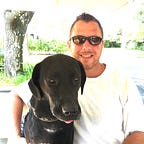Designing Version 1.0 of a New Product is A Lot Like Evacuating from a Hurricane
How do we decide what to take and what to leave behind, knowing there’s a real possibility what we leave might not be there when we return?
My wife and I have a lovely house at the beach in South Carolina. But we do have to deal with the annual threat of major hurricanes. For nearly ten years, we were fortunate to not be threatened by one. That all changed this year with Hurricane Matthew.
As category 4 Matthew churned slowly towards the southeast US coast, leaving massive destruction along the way, we began to accept the reality of having to evacuate for the first time. It wasn’t that hard a decision, really, thanks to the storm’s intensity and our governor’s order.
The implications of evacuating, however, were tougher to come to terms with. How do we secure our house? Where are we going to evacuate to? WHAT DO WE TAKE WITH US?
NEW PRODUCT DESIGN THINKING
This last question proved to be the most challenging. We’re not hoarders by any means. But being in our early 40s we have a good amount of stuff, together and individually, that we value. Not all of it could come with us.
How, then, should we go about deciding what to take and what to leave behind? Knowing there was a real possibility that whatever we left would not be there when we returned?
Turns out, it was helpful to think about the problem as if we were designing version 1.0 of a new product.
OUR PERSONAL MVP
In industry, when we design and build a new product, we focus on building the “Minimum Viable Product” or “MVP” for version 1.0. The MVP should only include those features that are necessary to prove we are delivering value to customers, and that they are willing to pay for it. This proof is often referred to as the “product-market fit.”
In that context, when thinking about what we needed to take with us when evacuating I tried the same logic: what is the minimum amount of stuff we need to take with us to prove we have value in our society if everything else is destroyed? What is our personal MVP?
I was on to something. Titles and deeds to cars and houses, insurance policies, birth certificates and passports, bank accounts, investment accounts, contracts, computer hard drives, diplomas, select clothes… the answers became self-evident. Unfortunately for me that also meant the St. Cyril basketball tournament most valuable player trophy from 1984 was not making the trip.
TIME AND RESOURCES
That got us through the essentials. But what about the rest of the stuff? What about the family heirlooms, photos (yes, we used to print photos on paper), artwork, electronic equipment, generator, and so on? To sort through those, I considered the two biggest constraints we are faced with when bringing a new product to market — time and resources.
In bringing a commercial product to market, whether it’s software or a bicycle, the “resource” constraint is usually money, especially for a startup. Many of us know that constraint all too well.
In the case of evacuating from Hurricane Matthew, our time to prepare was a little over 24 hours, and our resource constraint was the amount of cargo space in our Infiniti SUV and Chevy Silverado. After the dogs and cats and their gear, of course. There wasn’t enough time to evaluate everything thoroughly, and not enough room to take it if we could. That meant a lot was going to be left behind.
WHAT’S ON THE ROADMAP?
That realization sucked. I was feeling good about using the logic of Minimum Viable Product and applying time and resource constraints to get as far as we had. But there was still a lot of stuff we loved and didn’t want to just frivolously toss aside. What were we supposed to do about that?
That’s where the concept of a product roadmap came in handy. As product designers, we are constantly faced with the reality of having to exclude certain features we really, really cherish from v1.0. We just don’t have the time and resources. The product roadmap allows us to hold onto those features for use in future versions of the product if we are lucky enough to survive that long.
We took the same approach with the stuff we cherish but couldn’t take. We found the most secure place at a high elevation in the house and stored the items there. If they were lucky enough to survive, we would reunite with them later.
LET GO OF THE CLUTTER
Hurricane Matthew ran out of steam about ten days ago, but not before leaving a historic trail of destruction in its wake, including a final blow to unsuspecting North Carolina. We returned to our house in South Carolina a few days after.
Considering the eye of the storm crossed land only twenty miles away, we genuinely feel blessed to report the only significant damage we sustained resulted from the 2–3ft storm surge that flooded our property.
We did lose things to the flood waters. Items that had been stored under our house for years, but didn’t meet the criteria to bring upstairs with our more highly cherished possessions, were destroyed. You know what? We don’t miss them very much.
Like the features on your product roadmap, those were the items we kept pushing to the corner, to the next version, to make room for the things that were more important. And when they finally dropped off our roadmap, we barely mourned them.
